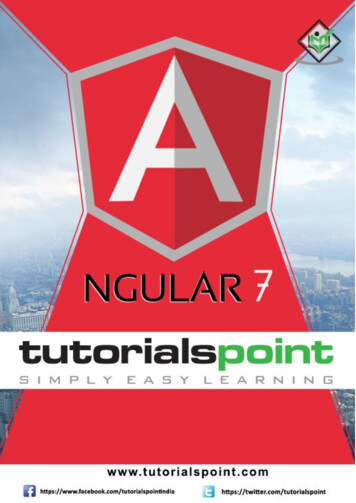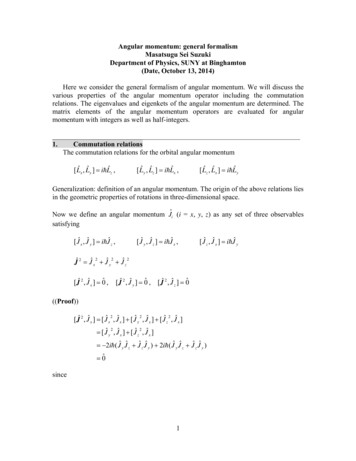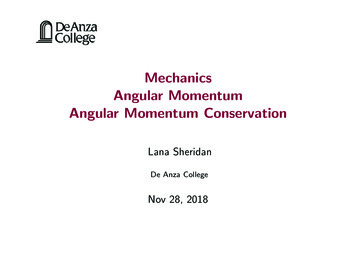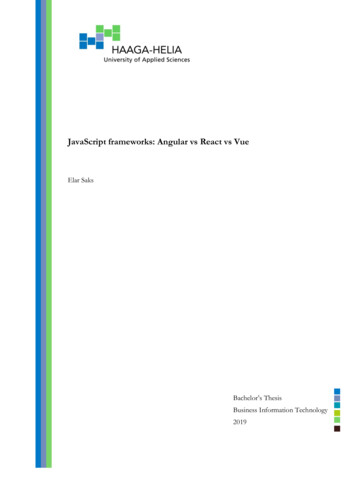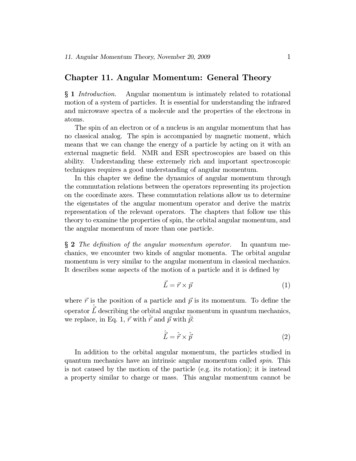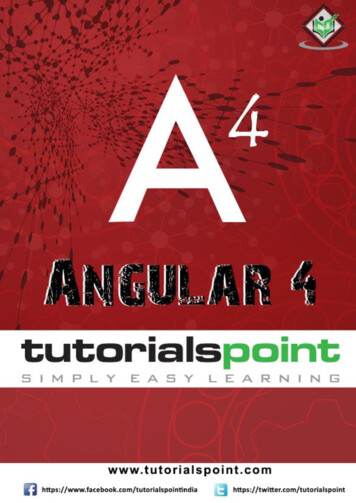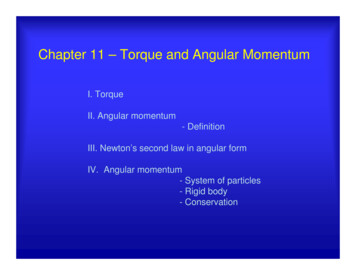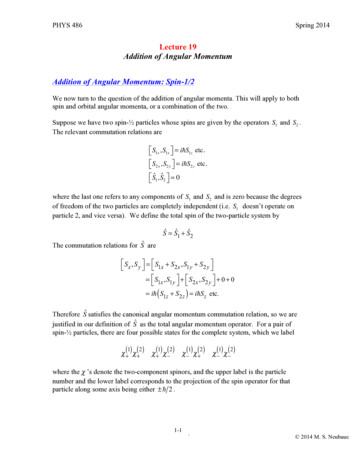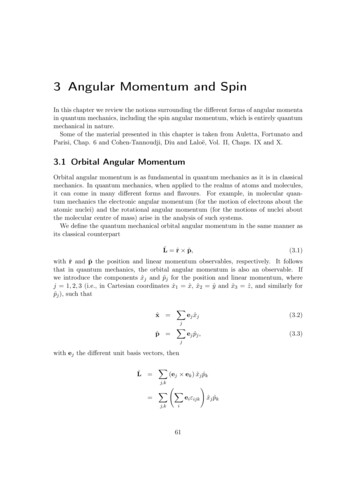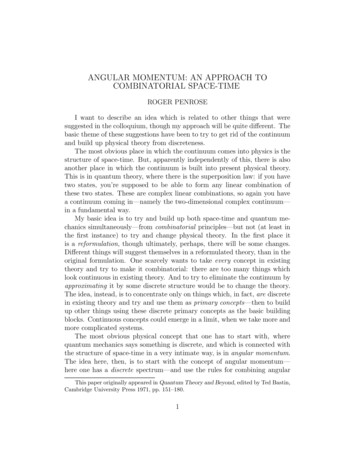
Transcription
ANGULAR MOMENTUM: AN APPROACH TOCOMBINATORIAL SPACE-TIMEROGER PENROSEI want to describe an idea which is related to other things that weresuggested in the colloquium, though my approach will be quite different. Thebasic theme of these suggestions have been to try to get rid of the continuumand build up physical theory from discreteness.The most obvious place in which the continuum comes into physics is thestructure of space-time. But, apparently independently of this, there is alsoanother place in which the continuum is built into present physical theory.This is in quantum theory, where there is the superposition law: if you havetwo states, you’re supposed to be able to form any linear combination ofthese two states. These are complex linear combinations, so again you havea continuum coming in—namely the two-dimensional complex continuum—in a fundamental way.My basic idea is to try and build up both space-time and quantum mechanics simultaneously—from combinatorial principles—but not (at least inthe first instance) to try and change physical theory. In the first place itis a reformulation, though ultimately, perhaps, there will be some changes.Different things will suggest themselves in a reformulated theory, than in theoriginal formulation. One scarcely wants to take every concept in existingtheory and try to make it combinatorial: there are too many things whichlook continuous in existing theory. And to try to eliminate the continuum byapproximating it by some discrete structure would be to change the theory.The idea, instead, is to concentrate only on things which, in fact, are discretein existing theory and try and use them as primary concepts—then to buildup other things using these discrete primary concepts as the basic buildingblocks. Continuous concepts could emerge in a limit, when we take more andmore complicated systems.The most obvious physical concept that one has to start with, wherequantum mechanics says something is discrete, and which is connected withthe structure of space-time in a very intimate way, is in angular momentum.The idea here, then, is to start with the concept of angular momentum—here one has a discrete spectrum—and use the rules for combining angularThis paper originally appeared in Quantum Theory and Beyond, edited by Ted Bastin,Cambridge University Press 1971, pp. 151–180.1
momenta together and see if in some sense one can construct the concept ofspace from this.One of the basic ideas here springs from something which always usedto worry me. Suppose you have an electron or some other spin 21 h̄ particle.You ask it about its spin: is it spinning up or down? But how does it knowwhich way is ‘up’ and which way is ‘down’ ? And you can equally well askthe question whether it spins right or left. But whatever question you askit about directions, the electron has only just two directions to choose from.Whether the alternatives are ‘up’ and ‘down’, or ‘right’ and ‘left’ depends onhow things are connected with the macroscopic world.Also you could consider a particle which has zero angular momentum.Quantum mechanics tells us that such a particle has to be spherically symmetrical. Therefore there isn’t really any choice of direction that the particlecan make (in its own rest-frame). In effect there is only one ‘direction’. Sothat a thing with zero angular momentum has just one ‘direction’ to choosefrom and with spin one-half it would have two ‘directions’ to choose from.Similarly, with spin one, there would always be just three ‘directions’ tochoose from, etc. Generally , there would be 2s 1 ‘directions’ available toa spin s object.Of course I don’t mean to imply that these are just directions in spacein the ordinary sense. I just mean that these are the choices available tothe object as regards its state of spin. That is, however we may choose tointerpret the different possibilities when viewed on a macroscopic scale, theobject itself is ‘aware’ only that these are the different possibilities that areopen to it. Thus, if the object is in an s-state, there is but one possibilityopen to it. If it is in a p-state there are three possibilities, etc., etc. I don’tmean that these possibilities are things that from a macroscopic point ofview we would necessarily think of as directions in all cases. The s-state isan example of a case where we would not!So we oughtn’t at the outset to have the concept of macroscopic spacedirection built into the theory. Instead, we ought to work with just thesediscrete alternatives open to particles or to simple systems. Since we don’twant to think of these alternatives as referring to pre-existing directions ofa background space—that would be to beg the question—we must deal onlywith total angular momentum (j-value) rather than spin in a direction (mvalue).Thus, the primary concept here has to be the concept of total angularmomentum not the concept of angular momentum in, say, the z-direction,2
because: which is the z-direction?Imagine, then, a universe built up of things like that shown in fig. 1.These lines may be thought of as the world-lines of particles. We can viewtime as going in one direction, say, from the bottom of the diagram to thetop. But it turns out, really, that it’s irrelevant which way time is going. SoI don’t want to worry too much about this.I’m going to put a number on each line. This number, the spin-numberFig. 1will have to be an integer. It will represent twice the angular momentum, inunits of h̄. All the information I’m allowed to know about this picture willbe just this diagram (fig. 2): the network of connections and spin numbers3, 2, 3, . . . like that. I should sayFig. 23
that the picture I want to give here is just a model. Although it does describea type of idealized situation exactly according to quantum theory, I certainlydon’t want to suggest that the universe ‘is’ this picture or anything like that.But it is not unlikely that some essential features of the model that I amdescribing could still have relevance in a more complete theory applicable tomore realistic situations.I have referred to these line segments as representing, in some way, theworld-lines of particles. But I don’t want to imply that these lines stand justfor elementary particles (say). Each line could represent some compoundsystem which separates itself from other such systems for long enough that(in some sense) it can be regarded as isolated and stationary, with a welldefined total angular momentum n 12 h̄. Let us call such a system or particlean n-unit. (We allow n 0, 1, 2, . . .) For the precise model I am describing,we must also imagine that the particles or systems are not moving relativeto one another. They just transfer angular momentum around, regroupingthemselves into different subsystems, perhaps annihilating one another, perhaps producing new units. In the diagram (fig. 2), the 3-unit at the bottomon the left splits into a 2-unit and another 3-unit. This second 3-unit combines with a 1-unit (produced in the break up of a 2-unit into two 1-units) tomake a new 2-unit, etc., etc. It is only the topological relationship betweenthe different segments, together with the spin-number values, which is tohave significance. The time-ordering of events will actually play no role here(except conceptually). We could, for example, read the diagram as thoughtime increased from the left to the right, rather than from the bottom to thetop, say.Angular momentum conservation will be involved when I finally give therules for these diagrams. These rules, though combinatorial, are actuallyderived from the standard quantum mechanics for angular momentum. Thus,in particular, the conservation of total angular momentum must be built intothe rules.Now, I want to indicate answers to two questions. First, what are thesecombinatorial rules and how are we to interpret them? Secondly, how doesthis enable us to build up a concept of space out of total angular momentum?In order not to get bogged down at this stage with too much detail, I shalldefer, until later on, the complete definition of the combinatorial rules thatwill be used. All I shall say at this stage is that every diagram, such as fig. 2(called a spin-network ) will be assigned a non-negative integer which I callits norm. In some vague way, we are to envisage that the norm of a diagram4
gives us a measure of the frequency of occurrence of that particular spinnetwork in the history of the universe. This is not actually quite right—Ishall be more precise later—but it will serve to orient our thinking. We shallbe able to use these norms to calculate the probabilities of various spin valuesoccurring in certain simple ‘experiments’. These probabilities will turn outalways to be rational numbers, arising from the fact that the norm is alwaysan integer. Given any spin-network, its norm can be calculated from it in apurely combinatorial way. I shall give the rule later.But first let me say something about the answer to the second question.How can I say anything about directions in space, when I only have the nondirectional concept of total angular momentum? How do I get ‘m-values’ outof j-values, in other words?Clearly we can’t do quite this. In order to know what the ‘m-value’of an n-unit is, we would require knowledge of which direction in space isthe ‘z-direction’. But the ‘z-direction’ has no physical meaning. Instead,we may ask for the ‘orientation’ of one of our n-units in relation to somelarger structure belonging to the system under consideration. We need somelarger structure which in fact does give us something that we may regardas a well-defined ‘direction in space’ and which could serve in place of the‘z-direction’. As we have seen, a structure of spin zero, being sphericallysymmetrical, is no good for this; spin 21 h̄ is not much better; spin h̄ onlya little better; and so on. Clearly we need a system involving a fairly largetotal angular momentum number if we are to obtain a reasonably well-defined‘direction’ against which to test the ‘spin direction’ of the smaller units. Wemay imagine that for a large total angular momentum number N , we havethe potentiality, at least, to define a well-defined direction as the spin axis ofthe system. Thus, if we define a ‘direction’ in space as something associatedwith an N -unit with a large N value (I call this a large unit), then we canask how to define angles between these ‘directions’. And if we can decide ona good way of measuring angles, we can then ask the question whether theangles we get are consistent with an interpretation in terms of directions in aEuclidean three-dimensional space, or perhaps in some other kind of space.How, then, are we to define an angle between two large units? Well, wedo this by performing an ‘experiment’. Suppose we detach a 1-unit (e.g. anelectron, or any other spin 21 h̄-particle) from a large N -unit in such a wayas to leave it as an (N 1)-unit. We can then re-attach the 1-unit to someother large unit, say an M -unit. What does the M -unit do? Well (accordingto the rules we are allowed here) it can either become an (M 1)-unit or5
an (M 1)-unit. There will be a certain probability of one outcome and acertain probability of the other. Knowing these probability values, we shallhave information as to the angle between the N -unit and the M -unit. Thus,if our two units are to be ‘parallel’, we would expect zero probability for theM 1 value and certainty for the M 1 value. If the two units are to be‘anti-parallel’ we would expect exactly the reverse probabilities. If they are‘perpendicular’, then we would expect equal probability values of 21 , for eachof the two outcomes. Generally, for an angle θ between the directions of thetwo large units we would expect aFig. 3probability 12 12 cos θ for the M -unit to be reduced to an (M 1)-unit anda probability 21 21 cos θ for it to be increased to an (M 1)-unit. Let medraw a diagram to represent this experiment (fig. 3). Here κ represents someknown spin-network. By means of a precise (combinatorial) calculationalprocedure—which I shall describe shortly—we can calculate, from knowledge of the spin-network κ, the probability of each of the two possible finaloutcomes. Hence, we have a way of getting hold of the concept of Euclideanangle, starting from a purely combinatorial scheme.As I remarked earlier, these probabilities will always turn out to be rational numbers. You might think, then, that I could only obtain angles withrational cosines in this way. But this would be a somewhat misleading way ofviewing the situation. With a finite spin-network with finite spin-numbers,6
the angle can never be quite well-enough defined. I can work out numericalvalues for these ‘cosines of angles’ for a finite spin-network, but these ‘angles’would normally not quite agree with the actual angle of Euclidean space untilI go to the limit.The view that I am expressing here is that rational probabilities are to beregarded as something which can be more primitive than ordinary real number probabilities. I don’t need to call upon the full continuum of probabilityvalues in order to proceed with the theory. A rational probability p m/nmight be thought of as arising because the universe has to make a choicebetween m alternative possibilities of one kind and n alternative possibilitiesof another—all of which are to be equally probable. Only in the limit, whennumbers go to infinity do we expect to get the full continuum of probabilityvalues.Fig. 4As a matter of fact, it was this question of rational values for primitiveprobabilities arising in nature, which really started me off on this entireline of thought concerning spin-networks, etc. The idea was to find somesituation in nature which one might reasonably regard as giving rise to a‘pure probability’, I am not really sure whether it is fair to assume that ‘pureprobabilities’ exist in nature, but by these I mean probabilities (necessarilyquantum mechanical) whose values are determined by nature alone and notin principle influenced by our ignorance of initial conditions, etc. I supposeI might have thought of branching ratios in particle decays as a possibleexample. Instead, I was led to consider a situation of the following type.Two spin zero particles each decay into pairs of spin 21 h̄ particles. Two ofthe spin 21 h̄ particles then come together, one from each pair, and combineto form a new particle (fig. 4). What is the spin of this new particle? Well,7
it must be either zero or h̄, with respective probabilities 14 and 34 (assumingno orbital components contribute, etc.). Although you can see that thereare objections even here to regarding this as giving a ‘pure probability’,at least the example served as a starting point. (This example was to someextent stimulated by Bohm’s version of the Einstein-Rosen-Podolsky thoughtexperiment, which it somewhat resembles.) The idea, then, is that any ‘pureprobability’ (if such exists) ought to be something arising ultimately out of achoice between equally probable alternatives. All ‘pure probabilities’ oughttherefore, to be rational numbers.Fig. 5But let me leave all this aside since it doesn’t affect the rest of the discussion. Actually, I haven’t quite finished my ‘angle measuring experiment’,so let me return to this.Let us consider the following particular situation. Suppose we have anumber of disconnected systems, each producing a large N -unit. There areto be absolutely no connections between them (fig. 5).Fig. 6Let me try to measure the ‘angle’ between two of them by doing one of the‘experiments’ I described earlier. I detach a 1-unit from one of the N -units8
in such a way as to leave it as an (N 1)-unit. Then I reattach the 1-unitto one of the other N -units (fig. 6). According to the rules (cf. later) it willfollow that the probability of the second N -unit to become an (N 1)-unitis 21 (N 1 1)/(N 1). These two probabilities become equal in the limitN . Thus, if we are to assign an ‘angle’ between these units, then, for Nlarge, this would have to be a right-angle. This is just using the probabilityblindly. I would similarly have to say, of any other pair of the N -units,that they are at right-angles. It would seem that I could put any numberof N -units at right-angles to each other. In this instance I have drawn five.Does this mean that we get a five-dimensional space?—or an -dimensionalspace?Clearly I have not done things quite right. There are no connections between any of the N -units here, so one would like to think of the probabilitiesthat arise out of one of these experiments as being not just due to the anglebetween the N -units (if they have an angle in some sense), but also due tothe ‘ignorance’ implicit in the set-up. That is, we think of the probabilitiesas arising in two different ways. In the first instance, probabilities can arisein this type of experiment, if we have a definite angle between two spinning bodies (as we have seen). These are the genuine quantum mechanicalprobabilities. But, in the second instance, we may just be uncertain as towhat the angle is between the two bodies. This lack of knowledge, concerning the history (or origins) of the two bodies, will give us a contribution tothe probability value—an ignorance factor—which will serve to obscure themeaning of the probability in terms of angles. In the present instance, we areallowed absolutely no information concerning the interconnections betweenthe different N -units, so the probability is9
Fig. 7not really due to ‘angle’ at all. In this extreme case, the probability is entirely‘ignorance factor’. In general, the two effects will be mixed up, so we shallneed a means of separating them.Let me change the picture a bit. I’ll put in some ‘known’ connectingnetwork (now denoted by κ) and have two large units coming out, as in fig. 7.I do one of these experiments, but then repeat the experiment. Suppose theN -unit is reduced to an (N 1)-unit and then to an (N 2)-unit. TheM -unit becomes an (M 1)-unit and then an (M 2)-unit, or an M -unitagain (fig. 8). The question is:10
Fig. 8is the probability of the second experiment influenced by the result of thefirst experiment? If this is essentially an ‘ignorance’ situation, where onedoesn’t initially know such about how the spin axes are pointing, then theresult of the first experiment provides us with some information as to therelative directions of the spin axes. Therefore, the probabilities in the second experiment will be altered by the knowledge of the result of the firstexperiment. If the probabilities calculated for the second experiment are not substantially altered by the knowledge of the result of the first experiment, then I saythat the angle between the two large units is essentially well-defined. If theyare substantially altered by the results of the first experiment, then there isa large ‘ignorance’ factor involved, and the probabilities arise not just from‘angle’. It should be borne in mind that all these probability values are simply calculated here,from knowledge of the spin-networks involved. The ‘experiments’ are really theoreticalconstructions. However, it would be possible (in principle—with the usual reservations)to measure these probabilities experimentally, by simply repeating the experiment manytimes, each time reconstructing the spin-network afresh.11
Fig. 9Suppose, now, we have the system shown in fig. 9, which has a numberof large units emerging, and suppose that it happens to be the case that theangle between any two of them is well-defined in the sense I just described.(All the numbers A, B, . . . are large compared with unity; I can do a fewodd experiments which do not much change these numbers.) Then there is atheorem which can be proved to the effect that these angles are all consistentwith angles between directions in Euclidean three-dimensional space.Now, should I be in any way surprised by this result? Admittedly I shouldhave been surprised if the method gave me any different space; but on theother hand, it is not completely clear to me that the result is somethingI could genuinely have inferred beforehand. Let me mention a number ofcurious features of the theory in this context. In the first place, suppose Iset the situation up with wave functions and everything, and work accordingto ordinary quantum mechanical rules. I have these particles (or systems)with large angular momentum, and I finally find out that I get these anglesconsistent with directions in Euclidean three-dimensional space. I never, atany stage, specified that these large angular momentum systems should, infact, correspond to bodies which do have well-defined directions (as rotationaxes). There are states with large total angular momentum (e.g. m 0states) which point all over the place, not necessarily in any one direction.12
I can start from some given Euclidean 3-space and use an ordinary Cartesian description in terms of x, y, z. I can use particles (or systems) with largetotal angular momentum, but which do not happen to give well-defined directions in the original space. Then I work out the ‘angles’ between themand find that these angle do not correspond to anything I can see as anglesin the original description, but they are nevertheless consistent with the angle between directions in some abstract Euclidean three-dimensional space. Itherefore take the view that the Euclidean three-dimensional space that I getout of all this, using probabilities, etc. is the real space, and that the originalspace, with its x, y, z’s that I wrote down, is an irrelevant convenience, likeco-ordinates in general relativity, where one writes down any co-ordinateswhich don’t necessarily mean anything. The central idea is that the systemdefines the geometry. If you like, you can use the conventional descriptionto fit the thing into the ‘ordinary space-time’ to begin with, but then thegeometry you get out is not necessarily the one you put into it. So I don’tknow whether I should be surprised or not by the fact that I actually get theright geometry in the end.There is a second aspect of this work that I think I regarded as slightlysurprising at first. This is the fact that although no complex numbers are everintroduced into the scheme, we can still build up the full three-dimensionalarray of directions, rather than, say, a two-dimensional subset. To representall possible directions as states of spin of a spin 21 h̄ particle, we need to takecomplex linear combinations (in the conventional formalism). Here we onlyuse rational numbers—and complex numbers cannot be approximated byrational numbers alone! Again, the answer seems to be that the space I endup with is not really the ‘same’ space as the (x, y, z)-space that I could startwith—even though both are Euclidean 3-spaces.One might ask whether corresponding rules might be invented which leadto other dimensional schemes. I don’t in fact see a priori why one shouldn’tbe able to invent rules, similar to the ones I use, for spaces of other dimensionality. But I’m not quite sure how one would do this. Also, it’s notobvious that the whole scheme for getting the space out in the end wouldstill work. The rules I use are derived from the irreducible representations ofSO(3). These have some rather unique features.Now, from what I’ve said so far, you might wonder whether you wouldjust scatter the numbers on the network at random. Actually, you can ifyou like, but unless you are a bit careful the resulting spin-network will havezero norm. And if the norm is zero, then the situation represented by the13
spin-network a not realizable (i.e. zero probability) according to the rules ofquantum mechanics.There are, in fact, two simple necessary requirements which must besatisfied at each vertex of a spin-network, for its norm to be non-zero. Noticefirst that all the spin-networks that I have explicitly drawn have the propertythat precisely three edges (i.e. units) come together at each vertex. (This isn’tone of the ‘requirements’ I am referring to. It’s just that I don’t know howone would handle more general types of vertex within the scheme.) Supposewe have a vertex at which an a-unit, a b-unit and a c-unit come together(fig. 10).Fig. 10Then for a spin-network containing the vertex to have a non-zero norm, it isnecessary that the triangle inequality hold:a b c 2 max(a, b, c) ;and furthermore that there be conservation of fermion number (mod 2):a b c is even.These are, of course, properties that one would want to hold in real physicalprocesses, with the interpretations that I have given to the spin-networks.But even if these requirements hold at every vertex, the spin-network maystill have zero norm. For example, each of the two types of spin-network14
shown in fig. 11 has zero norm, where n 6 0 in the first case and n 6 m thesecond. In each case, the shaded portion represents some spin-network withno other free ends. In fact, theFig. 11Fig. 12first is effectively a special case of the second, with m 0. This is becauseany 0-unit can be omitted from a spin-network (if we also suitably deletethe relevant vertices) without changing the norm. We may interpret the15
vanishing of the norm whenever n 6 m in the second case as an expressionof conservation of total angular momentum.In addition to these cases, there are many particular spin-networks whichturn out to have zero norm. One example is shown in fig. 12. But so far Ihave only been giving particular cases. Let us now pass to the general rule.I shall give the definition of the norm in terms of a closely related concept,namely, what I shall call the value of a closed oriented spin-network. I calla spin-network closed if it has no free ends (e.g. analogous to a disconnectedvacuum process). A spin-network which is not closed will not be assigneda value. The definition of orientation for a spin-network is a little difficultto give concisely. Any spin-network can be assigned two alternative orientations. Fixing the orientation of a closed spin-network will serve to define thesign of its value (which can be positive or negative). Roughly speaking theorientation assigns a cyclic order to the three units attached to each vertex—but if we reverse the cyclic order at any even number of vertices this is toleave the orientation unchanged. The orientation will change, on the otherhand, if the cyclic order is reversed at an odd number of vertices.I shall adopt the convention, when drawing spin-networks, that the orientation is to be fixed by the way that the spin-network is depicted on theplane. At each vertex we specify ‘counter-clockwise’ as the cyclic order forthe three units attached to the vertex. This defines the spin-network’s orientation. The diagrams in fig. 13 illustrate an example of a closed spin-networkwith its two possible orientations.Fig. 13It will also be convenient to use the representation of a spin-network as16
a drawing on a plane, in order to keep track of signs properly when defining the value. This may have the effect of making the definition seem less‘combinatorial’ than it really is. Of course, the definition could be reformulated without the use of such a drawing if desired. Consider, then, a closedspin-network α depicted as aFig. 14drawing on a plane. Now, imagine each n-unit to be replaced in the drawingby n parallel strands. At each vertex, the strand ends must be connectedtogether in pairs, but no two strands associated with the same n-unit areto be connected together. Let us call such a connection scheme a vertexconnection. One such vertex connection is illustrated in fig. 14, while fig. 15shows a non-allowable connection,Fig. 15since two strands of the 7-unit are connected to one another. The sign ofa vertex connection is defined most simply as ( 1)x where x is the number17
of intersection points between different strands at the vertex, as drawn onthe plane. (These intersection points must be counted correctly if morethan two strands cross at a point, or if two strands touch: and ignored ifa strand crosses itself. It is simplest on the other hand, just to avoid suchfeatures by drawing the strands in general position and not allowing anystrand connection to cross itself.) The sign of a vertex connection, in fact,does not depend on the details of how it is drawn, but only on the pairingoff of the strands. The allowable vertex connection depicted above has 1as its sign, since there are thirteen crossing points.When the vertex connections have been completed at every vertex ofa closed spin-network, then we shall have a number of closed loops, withno open-ended strands remaining. Consider, now, every possible way ofallowably completing the vertex connection for the spin-network α. We formthe expressionP ( 2)cvalue of α Qn!where the summation extends over all possible completed allowable connection schemes, where the ‘ ’ stands for the product of the signs of all thevertex connections, where c is the number of closed loops resulting from thevertex connections and where the product in the denominator ranges overall the units of the spin-network, n being the spin-number of the unit. Thevalue of any closed spin-network always turns out to be an integer.Fig. 161{ ( 2) ( 2)2 ( 2)2 ( 2)}2! 1! 1! 6. value Let us consider a simple example, given in fig. 16. Note that the ‘accidental’ intersection, arising from the crossing of the two 1-units in the firstdrawing of the spin-network, does not contribute to the sign of the terms inthe sum. Only the intersections at the vertex connections count.18
The definition of the value of a closed oriented spin-network that I havejust given is perhaps the simplest to state, but it is by no means the mostuseful to use in actual calculations. When the spin-networks become evenslightly more complicated than the simple one evaluated above, the detailedcalculations can b
haps producing new units. In the diagram ( g. 2), the 3-unit at the bottom on the left splits into a 2-unit and another 3-unit. This second 3-unit com-bines with a 1-unit (produced in the break up of a 2-unit into two 1-units) to make a new 2-unit, etc., etc. It is only the topological relationship between

